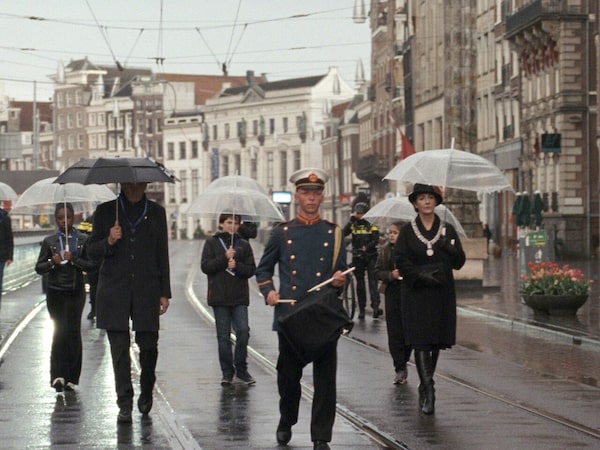- Occupied City
- Directed by Steve McQueen
- Written by Bianca Stigter
- Featuring the voice of Melanie Hyams
- Classification PG; 266 minutes
- Opens at the TIFF Lightbox in Toronto April 26
That there might be a limited audience for Steve McQueen’s latest film, Occupied City, seems of little interest to the 12 Years A Slave and Widows director. A documentary whose length clocks in at just under 4½ hours (including a benevolent 15-minute intermission), Occupied City is not so much epic as it is monumental, if not encyclopedic.
Adapted from wife and fellow filmmaker Bianca Stigter’s 560-page illustrated history, Atlas of an Occupied City: Amsterdam 1940-1945, the film compiles a detailed cartography of her home city as it existed under Nazi occupation. As McQueen shepherds his viewer to 130 different addresses throughout the city, British voice actor Melanie Hyams narrates, offering a reserved retelling of the history of each site partnered with present-day footage of the quotidian goings-on of contemporary Amsterdam life.
Only 2 per cent of the Netherlands was designated Jewish at the time of German occupation in 1940 (a number McQueen’s film overstates as 10 per cent) and the majority of this population was systematically murdered during the Holocaust. It is with the knowledge of such wretched acts that the director maps out Amsterdam, moving non-chronologically in both time and space, bearing witness while eschewing sentimentality.
While the present-day footage charts the beginnings of the COVID-19 pandemic in the Netherlands, it’s only part of a series of parallels that organically trace the echoes of time and space, rather than an attempt at an obvious (and heavy-handed) direct comparison to the Nazi occupation.
We are given a view of Amsterdam in lockdown, where a state-mandated curfew has been put into effect for the first time since the Second World War. In these present years, protests emerge throughout the city as citizens come together to rally for social causes, only to be met with tear gas, water cannons and drone surveillance – the weapons of counter-revolution utilized by the Dutch government, which sees fit to enact a militarized response to civic action.

The past collides with the present in Occupied City, an excavation of the Nazi occupation of Amsterdam.Handout
It is a continuation of the film’s desire to both chronicle and situate history in time and space, documenting loss and resistance (both past and present) alongside the beauty and banality of the everyday. Just as we hear of Jewish families separated and transported to concentration camps, resistance fighters plagued by turncoats, Dutch city officials who used their positions to aid their Jewish comrades in attempts to survive, we see contemporary families enjoying a sunny day tobogganing on a city slope, middle-aged men working out on ellipticals from within the confines of newly built high-rise buildings, interior scenes of domesticity as viewed through ever-open Dutch windows.
McQueen’s impulse here is less a detailed map to scale in which we can place each action we see or hear of, and more a collection of moments bound, in their geography, to speak alongside one another. It’s an approach that’s more akin to textures accumulated over time; the relations here are organic, an approach that the British filmmaker has compared to “an English garden” – here, the rhyming of sound, image and history is as intentional as it is incidental.
What is most refreshing about Occupied City is its attempts at studying such a history without use of archival materials, talking heads or any of the usual techniques of documentary filmmaking that have patterned retellings of Jewish histories of persecution onscreen over the past several decades. McQueen offers a film that isn’t dispassionate, but rather, with an awareness of such a lengthy history of narrative representation, likens itself to testimony rather than re-enactment.
It’s no doubt an interesting choice that succeeds just as much as it is perhaps unable to fully account for the emotional weight of its subject matter. McQueen seems aware of this, content as a filmmaker to settle his film within this contested space. Here, the act of sharing histories oft regarded as unrepresentable is more a study in both the demands and limits of filmmaking rather than a problematic to be solved in and of itself.
It’s an ascetic meditation on form and duration that would be best received by arthouse audiences in search of a marathon of a city symphony film that – while certainly enacting its own kind of quiet lyricism and poetics – is patterned only modestly with more expressive visual flourishes. As much as Occupied City’s observational eye is rooted in a humanistic and cumulative approach to history, it will, no doubt, leave those in search of a less austere approach wanting.
Editor’s note: This article has been updated to clarify that 2 per cent of the Netherlands was designated Jewish at the time of the German occupation in 1940, and that the lockdown for COVID-19 was the first state-mandated curfew since the Second World War.